ENTD321 Fall 18 IT Online Training Application Design Specification
VerifiedAdded on 2023/04/19
|19
|3743
|145
Report
AI Summary
This document provides a comprehensive design specification for an IT online training application. It covers various aspects including system architecture, assumptions, dependencies, constraints, and architectural designs. The system functionalities include purchasing products, maintaining customer and product information, managing instructors, shopping carts, payment cards, user management menus, and accounting services. The document also details the 4+1 architectural view, including logical, process, development, deployment, and use case views, represented through UML diagrams. Furthermore, it includes application class designs with detailed class diagrams, illustrating classes, attributes, operations, and visibility for key entities like users and employees. This design aims to provide a robust and scalable platform for online IT training.
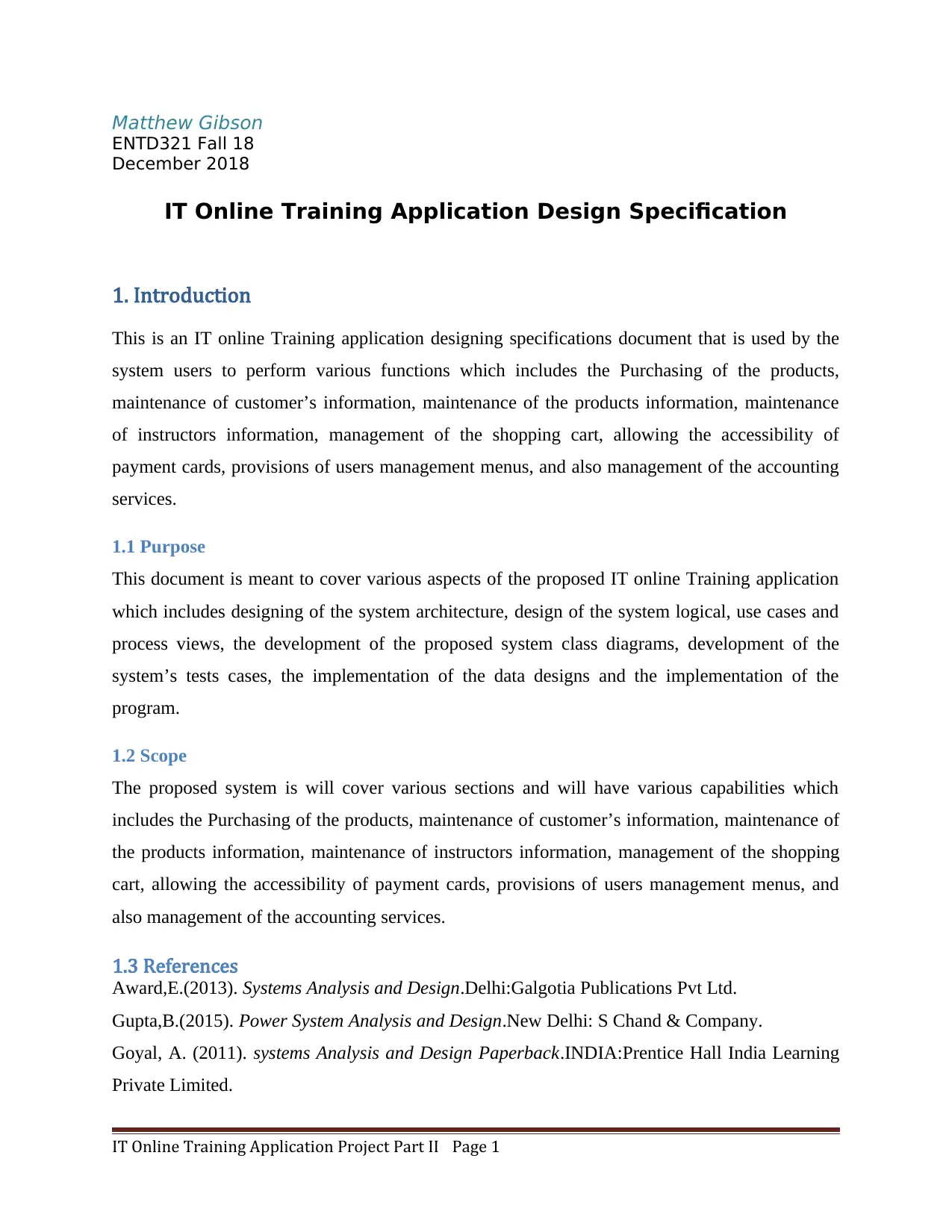
Matthew Gibson
ENTD321 Fall 18
December 2018
IT Online Training Application Design Specification
1. Introduction
This is an IT online Training application designing specifications document that is used by the
system users to perform various functions which includes the Purchasing of the products,
maintenance of customer’s information, maintenance of the products information, maintenance
of instructors information, management of the shopping cart, allowing the accessibility of
payment cards, provisions of users management menus, and also management of the accounting
services.
1.1 Purpose
This document is meant to cover various aspects of the proposed IT online Training application
which includes designing of the system architecture, design of the system logical, use cases and
process views, the development of the proposed system class diagrams, development of the
system’s tests cases, the implementation of the data designs and the implementation of the
program.
1.2 Scope
The proposed system is will cover various sections and will have various capabilities which
includes the Purchasing of the products, maintenance of customer’s information, maintenance of
the products information, maintenance of instructors information, management of the shopping
cart, allowing the accessibility of payment cards, provisions of users management menus, and
also management of the accounting services.
1.3 References
Award,E.(2013). Systems Analysis and Design.Delhi:Galgotia Publications Pvt Ltd.
Gupta,B.(2015). Power System Analysis and Design.New Delhi: S Chand & Company.
Goyal, A. (2011). systems Analysis and Design Paperback.INDIA:Prentice Hall India Learning
Private Limited.
IT Online Training Application Project Part II Page 1
ENTD321 Fall 18
December 2018
IT Online Training Application Design Specification
1. Introduction
This is an IT online Training application designing specifications document that is used by the
system users to perform various functions which includes the Purchasing of the products,
maintenance of customer’s information, maintenance of the products information, maintenance
of instructors information, management of the shopping cart, allowing the accessibility of
payment cards, provisions of users management menus, and also management of the accounting
services.
1.1 Purpose
This document is meant to cover various aspects of the proposed IT online Training application
which includes designing of the system architecture, design of the system logical, use cases and
process views, the development of the proposed system class diagrams, development of the
system’s tests cases, the implementation of the data designs and the implementation of the
program.
1.2 Scope
The proposed system is will cover various sections and will have various capabilities which
includes the Purchasing of the products, maintenance of customer’s information, maintenance of
the products information, maintenance of instructors information, management of the shopping
cart, allowing the accessibility of payment cards, provisions of users management menus, and
also management of the accounting services.
1.3 References
Award,E.(2013). Systems Analysis and Design.Delhi:Galgotia Publications Pvt Ltd.
Gupta,B.(2015). Power System Analysis and Design.New Delhi: S Chand & Company.
Goyal, A. (2011). systems Analysis and Design Paperback.INDIA:Prentice Hall India Learning
Private Limited.
IT Online Training Application Project Part II Page 1
Paraphrase This Document
Need a fresh take? Get an instant paraphrase of this document with our AI Paraphraser
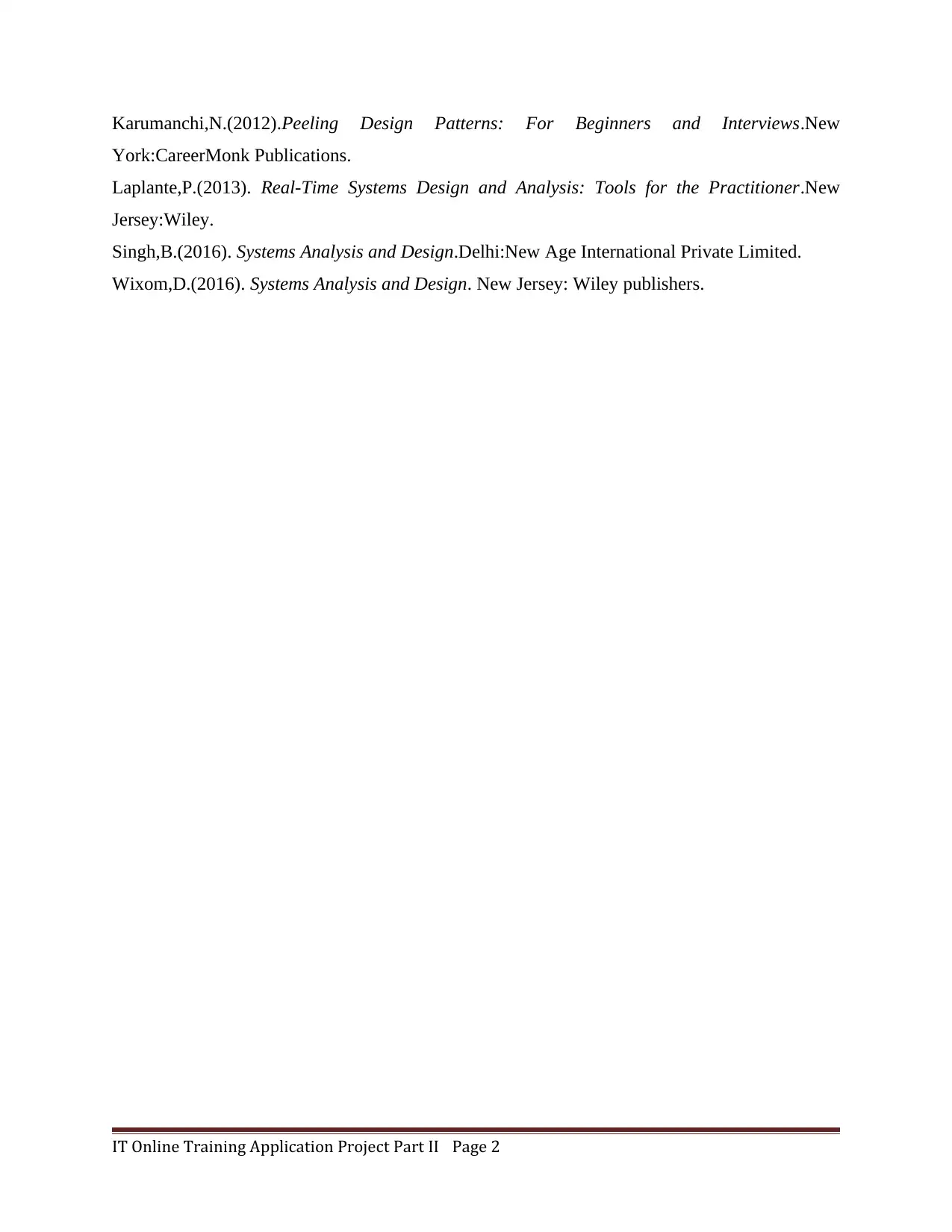
Karumanchi,N.(2012).Peeling Design Patterns: For Beginners and Interviews.New
York:CareerMonk Publications.
Laplante,P.(2013). Real-Time Systems Design and Analysis: Tools for the Practitioner.New
Jersey:Wiley.
Singh,B.(2016). Systems Analysis and Design.Delhi:New Age International Private Limited.
Wixom,D.(2016). Systems Analysis and Design. New Jersey: Wiley publishers.
IT Online Training Application Project Part II Page 2
York:CareerMonk Publications.
Laplante,P.(2013). Real-Time Systems Design and Analysis: Tools for the Practitioner.New
Jersey:Wiley.
Singh,B.(2016). Systems Analysis and Design.Delhi:New Age International Private Limited.
Wixom,D.(2016). Systems Analysis and Design. New Jersey: Wiley publishers.
IT Online Training Application Project Part II Page 2
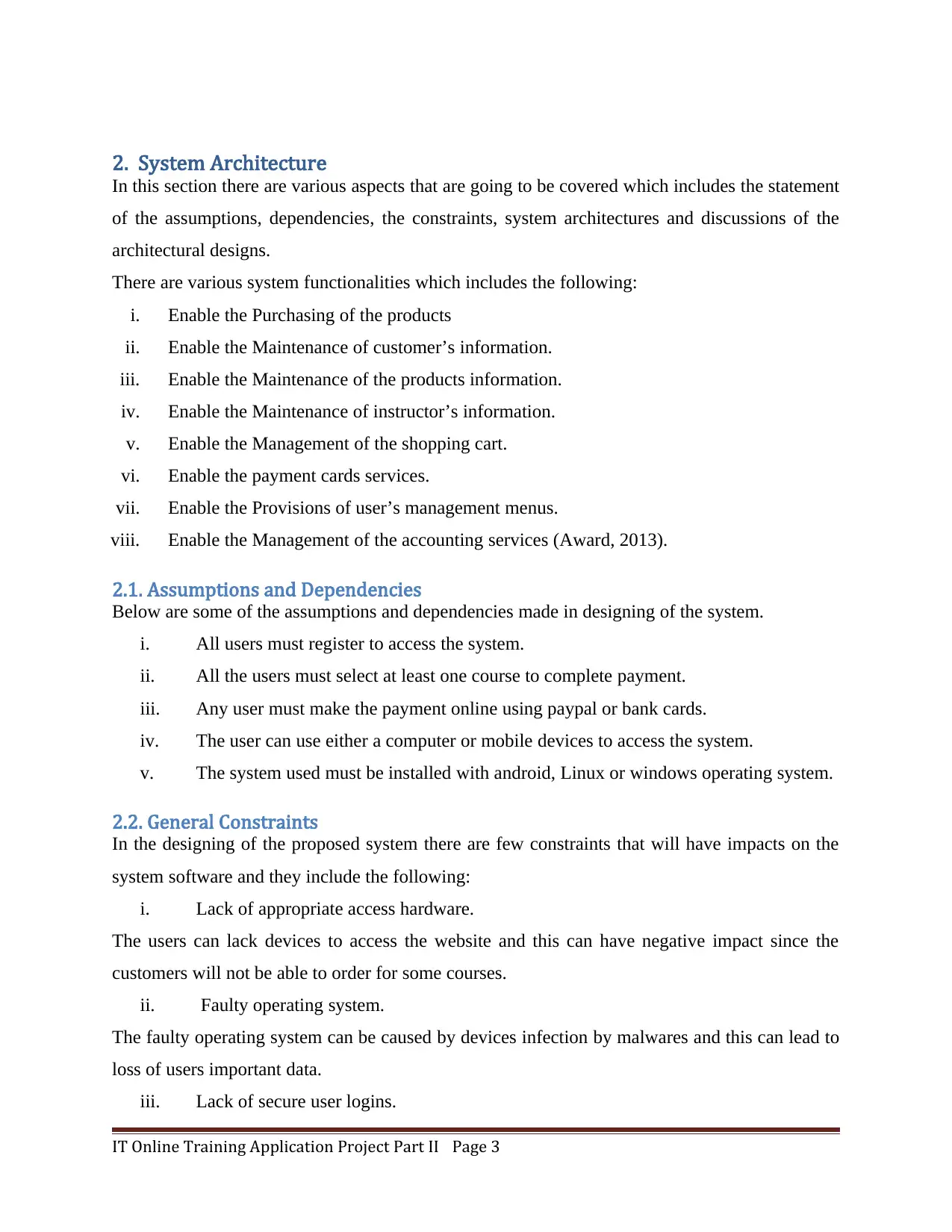
2. System Architecture
In this section there are various aspects that are going to be covered which includes the statement
of the assumptions, dependencies, the constraints, system architectures and discussions of the
architectural designs.
There are various system functionalities which includes the following:
i. Enable the Purchasing of the products
ii. Enable the Maintenance of customer’s information.
iii. Enable the Maintenance of the products information.
iv. Enable the Maintenance of instructor’s information.
v. Enable the Management of the shopping cart.
vi. Enable the payment cards services.
vii. Enable the Provisions of user’s management menus.
viii. Enable the Management of the accounting services (Award, 2013).
2.1. Assumptions and Dependencies
Below are some of the assumptions and dependencies made in designing of the system.
i. All users must register to access the system.
ii. All the users must select at least one course to complete payment.
iii. Any user must make the payment online using paypal or bank cards.
iv. The user can use either a computer or mobile devices to access the system.
v. The system used must be installed with android, Linux or windows operating system.
2.2. General Constraints
In the designing of the proposed system there are few constraints that will have impacts on the
system software and they include the following:
i. Lack of appropriate access hardware.
The users can lack devices to access the website and this can have negative impact since the
customers will not be able to order for some courses.
ii. Faulty operating system.
The faulty operating system can be caused by devices infection by malwares and this can lead to
loss of users important data.
iii. Lack of secure user logins.
IT Online Training Application Project Part II Page 3
In this section there are various aspects that are going to be covered which includes the statement
of the assumptions, dependencies, the constraints, system architectures and discussions of the
architectural designs.
There are various system functionalities which includes the following:
i. Enable the Purchasing of the products
ii. Enable the Maintenance of customer’s information.
iii. Enable the Maintenance of the products information.
iv. Enable the Maintenance of instructor’s information.
v. Enable the Management of the shopping cart.
vi. Enable the payment cards services.
vii. Enable the Provisions of user’s management menus.
viii. Enable the Management of the accounting services (Award, 2013).
2.1. Assumptions and Dependencies
Below are some of the assumptions and dependencies made in designing of the system.
i. All users must register to access the system.
ii. All the users must select at least one course to complete payment.
iii. Any user must make the payment online using paypal or bank cards.
iv. The user can use either a computer or mobile devices to access the system.
v. The system used must be installed with android, Linux or windows operating system.
2.2. General Constraints
In the designing of the proposed system there are few constraints that will have impacts on the
system software and they include the following:
i. Lack of appropriate access hardware.
The users can lack devices to access the website and this can have negative impact since the
customers will not be able to order for some courses.
ii. Faulty operating system.
The faulty operating system can be caused by devices infection by malwares and this can lead to
loss of users important data.
iii. Lack of secure user logins.
IT Online Training Application Project Part II Page 3
⊘ This is a preview!⊘
Do you want full access?
Subscribe today to unlock all pages.

Trusted by 1+ million students worldwide
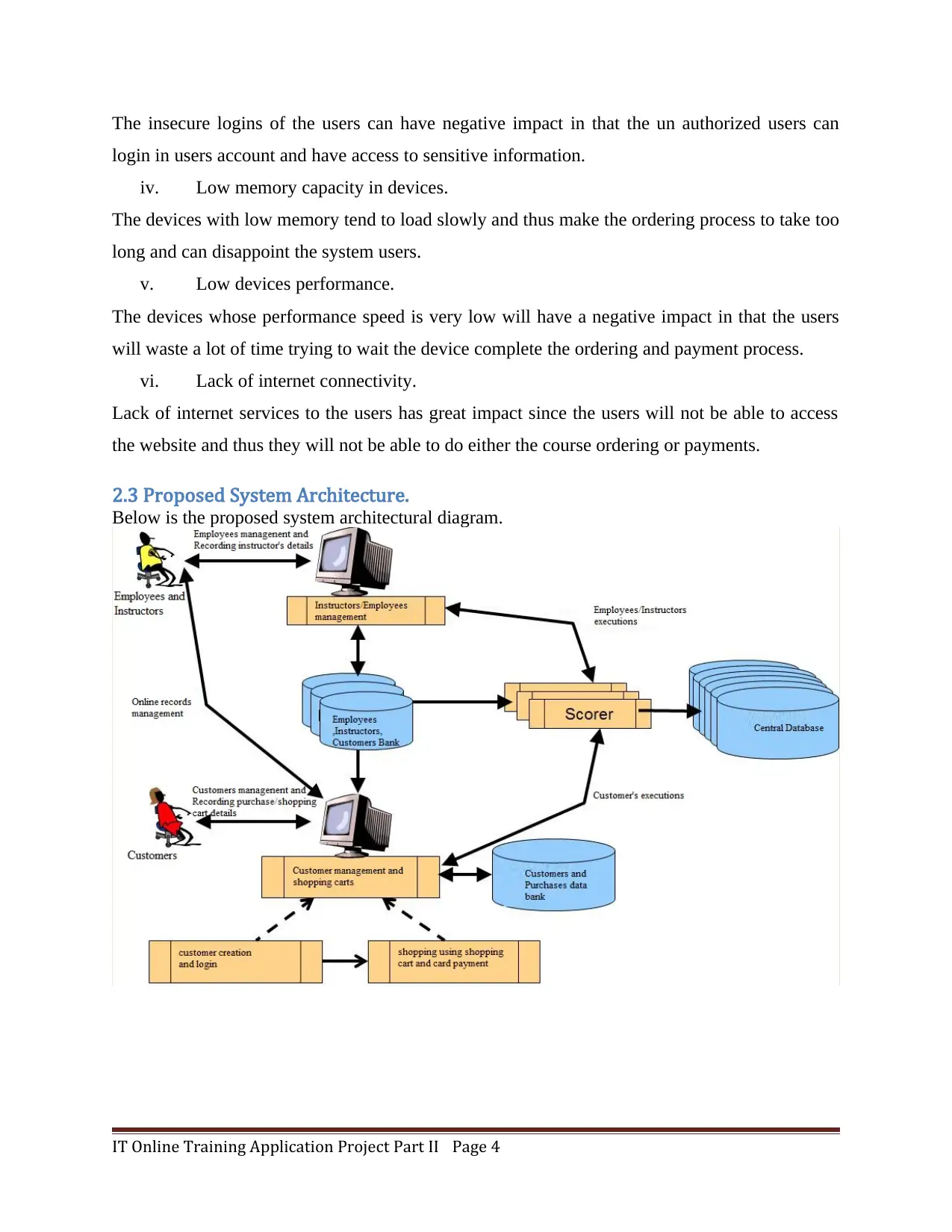
The insecure logins of the users can have negative impact in that the un authorized users can
login in users account and have access to sensitive information.
iv. Low memory capacity in devices.
The devices with low memory tend to load slowly and thus make the ordering process to take too
long and can disappoint the system users.
v. Low devices performance.
The devices whose performance speed is very low will have a negative impact in that the users
will waste a lot of time trying to wait the device complete the ordering and payment process.
vi. Lack of internet connectivity.
Lack of internet services to the users has great impact since the users will not be able to access
the website and thus they will not be able to do either the course ordering or payments.
2.3 Proposed System Architecture.
Below is the proposed system architectural diagram.
IT Online Training Application Project Part II Page 4
login in users account and have access to sensitive information.
iv. Low memory capacity in devices.
The devices with low memory tend to load slowly and thus make the ordering process to take too
long and can disappoint the system users.
v. Low devices performance.
The devices whose performance speed is very low will have a negative impact in that the users
will waste a lot of time trying to wait the device complete the ordering and payment process.
vi. Lack of internet connectivity.
Lack of internet services to the users has great impact since the users will not be able to access
the website and thus they will not be able to do either the course ordering or payments.
2.3 Proposed System Architecture.
Below is the proposed system architectural diagram.
IT Online Training Application Project Part II Page 4
Paraphrase This Document
Need a fresh take? Get an instant paraphrase of this document with our AI Paraphraser
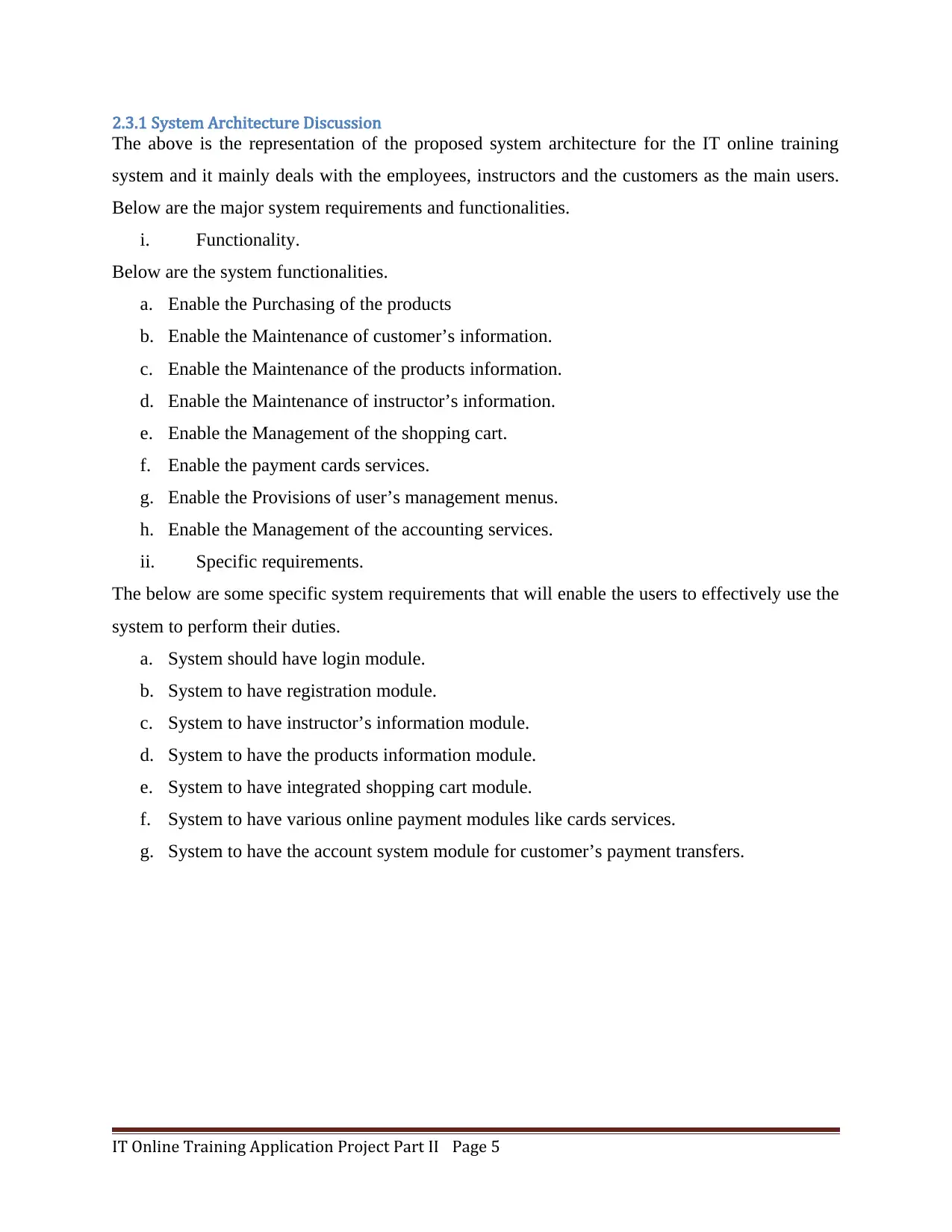
2.3.1 System Architecture Discussion
The above is the representation of the proposed system architecture for the IT online training
system and it mainly deals with the employees, instructors and the customers as the main users.
Below are the major system requirements and functionalities.
i. Functionality.
Below are the system functionalities.
a. Enable the Purchasing of the products
b. Enable the Maintenance of customer’s information.
c. Enable the Maintenance of the products information.
d. Enable the Maintenance of instructor’s information.
e. Enable the Management of the shopping cart.
f. Enable the payment cards services.
g. Enable the Provisions of user’s management menus.
h. Enable the Management of the accounting services.
ii. Specific requirements.
The below are some specific system requirements that will enable the users to effectively use the
system to perform their duties.
a. System should have login module.
b. System to have registration module.
c. System to have instructor’s information module.
d. System to have the products information module.
e. System to have integrated shopping cart module.
f. System to have various online payment modules like cards services.
g. System to have the account system module for customer’s payment transfers.
IT Online Training Application Project Part II Page 5
The above is the representation of the proposed system architecture for the IT online training
system and it mainly deals with the employees, instructors and the customers as the main users.
Below are the major system requirements and functionalities.
i. Functionality.
Below are the system functionalities.
a. Enable the Purchasing of the products
b. Enable the Maintenance of customer’s information.
c. Enable the Maintenance of the products information.
d. Enable the Maintenance of instructor’s information.
e. Enable the Management of the shopping cart.
f. Enable the payment cards services.
g. Enable the Provisions of user’s management menus.
h. Enable the Management of the accounting services.
ii. Specific requirements.
The below are some specific system requirements that will enable the users to effectively use the
system to perform their duties.
a. System should have login module.
b. System to have registration module.
c. System to have instructor’s information module.
d. System to have the products information module.
e. System to have integrated shopping cart module.
f. System to have various online payment modules like cards services.
g. System to have the account system module for customer’s payment transfers.
IT Online Training Application Project Part II Page 5

3. 4+1 Architecture
In this section there are various aspects to be covered which includes the design of the system
logic view that highlights the application functionalities, the process view that highlights the
non-functional aspects of the system, the development views that highlights the system
architectures, the deployment views that highlights the system topology nodes formation, and the
use cases views that highlights the descriptions of the system behaviors.
3.1 Logical View
The below UML diagram shows the logical view for the IT online training system which is made
of various of various objects that helps in the realization of the functionalities of the proposed
system , the above UML diagram is the proposed for the system implementation where the users
object stores the details of the system users and their login passwords and usernames, the
employees object is used to store the employees details , the instructors object is used to store the
instructors details , the customer objects are used to store the customers details , the shopping
cart records the details of the customer, and the products to be purchased , the payments object
stores the payment made for the products though the shopping cart and the accounting system
while the product object stores the details about the products available in the store to be bought.
(Gupta, 2015).
3.2 Process View
The below UML sequence diagram which is the process view that demonstrates the threads of
the system operations between the various users and objects, the view shows the system
performance which is high due to the high system features , the system is also scalable as it
allows the execution of various processes at a time, the system also supports concurrency as
IT Online Training Application Project Part II Page 6
In this section there are various aspects to be covered which includes the design of the system
logic view that highlights the application functionalities, the process view that highlights the
non-functional aspects of the system, the development views that highlights the system
architectures, the deployment views that highlights the system topology nodes formation, and the
use cases views that highlights the descriptions of the system behaviors.
3.1 Logical View
The below UML diagram shows the logical view for the IT online training system which is made
of various of various objects that helps in the realization of the functionalities of the proposed
system , the above UML diagram is the proposed for the system implementation where the users
object stores the details of the system users and their login passwords and usernames, the
employees object is used to store the employees details , the instructors object is used to store the
instructors details , the customer objects are used to store the customers details , the shopping
cart records the details of the customer, and the products to be purchased , the payments object
stores the payment made for the products though the shopping cart and the accounting system
while the product object stores the details about the products available in the store to be bought.
(Gupta, 2015).
3.2 Process View
The below UML sequence diagram which is the process view that demonstrates the threads of
the system operations between the various users and objects, the view shows the system
performance which is high due to the high system features , the system is also scalable as it
allows the execution of various processes at a time, the system also supports concurrency as
IT Online Training Application Project Part II Page 6
⊘ This is a preview!⊘
Do you want full access?
Subscribe today to unlock all pages.

Trusted by 1+ million students worldwide
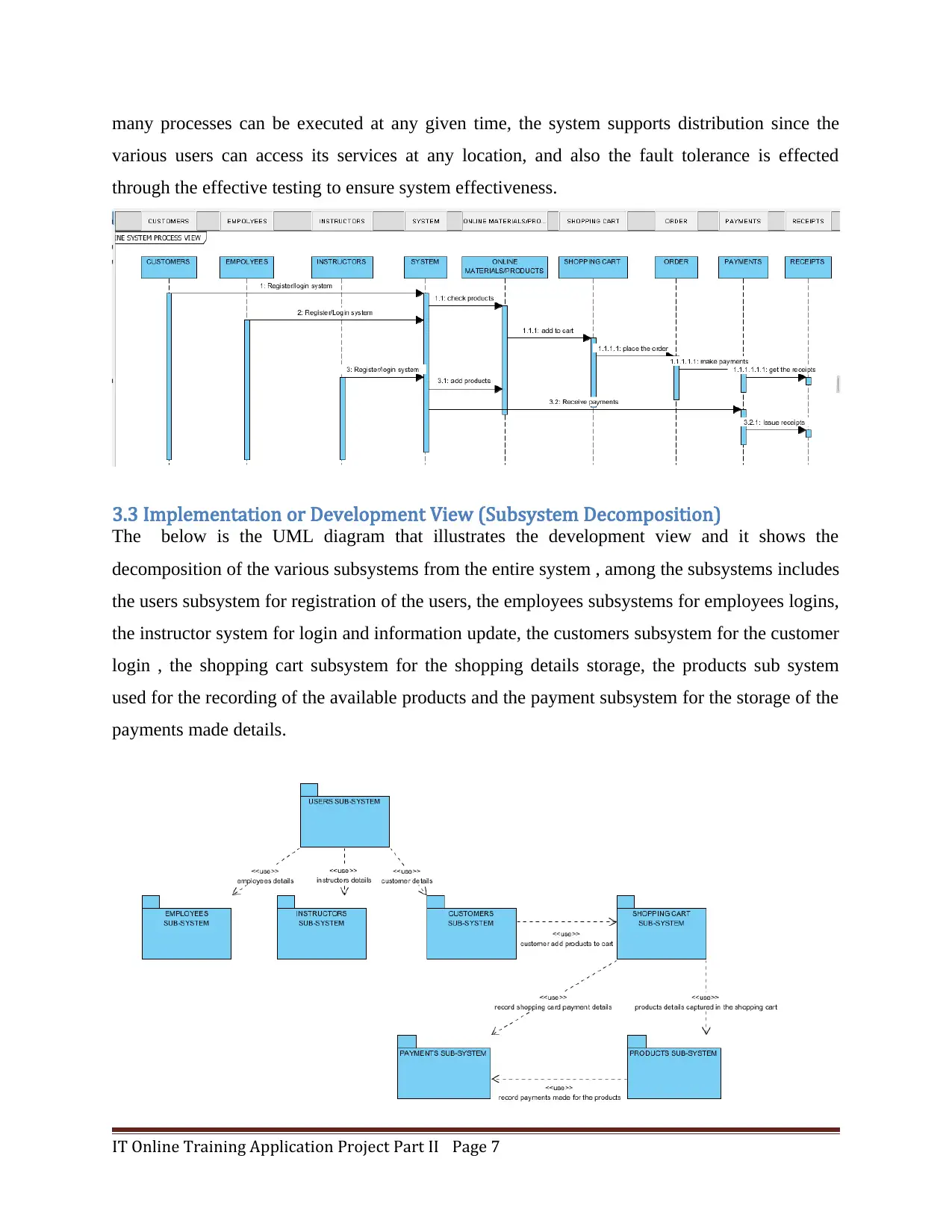
many processes can be executed at any given time, the system supports distribution since the
various users can access its services at any location, and also the fault tolerance is effected
through the effective testing to ensure system effectiveness.
3.3 Implementation or Development View (Subsystem Decomposition)
The below is the UML diagram that illustrates the development view and it shows the
decomposition of the various subsystems from the entire system , among the subsystems includes
the users subsystem for registration of the users, the employees subsystems for employees logins,
the instructor system for login and information update, the customers subsystem for the customer
login , the shopping cart subsystem for the shopping details storage, the products sub system
used for the recording of the available products and the payment subsystem for the storage of the
payments made details.
IT Online Training Application Project Part II Page 7
various users can access its services at any location, and also the fault tolerance is effected
through the effective testing to ensure system effectiveness.
3.3 Implementation or Development View (Subsystem Decomposition)
The below is the UML diagram that illustrates the development view and it shows the
decomposition of the various subsystems from the entire system , among the subsystems includes
the users subsystem for registration of the users, the employees subsystems for employees logins,
the instructor system for login and information update, the customers subsystem for the customer
login , the shopping cart subsystem for the shopping details storage, the products sub system
used for the recording of the available products and the payment subsystem for the storage of the
payments made details.
IT Online Training Application Project Part II Page 7
Paraphrase This Document
Need a fresh take? Get an instant paraphrase of this document with our AI Paraphraser
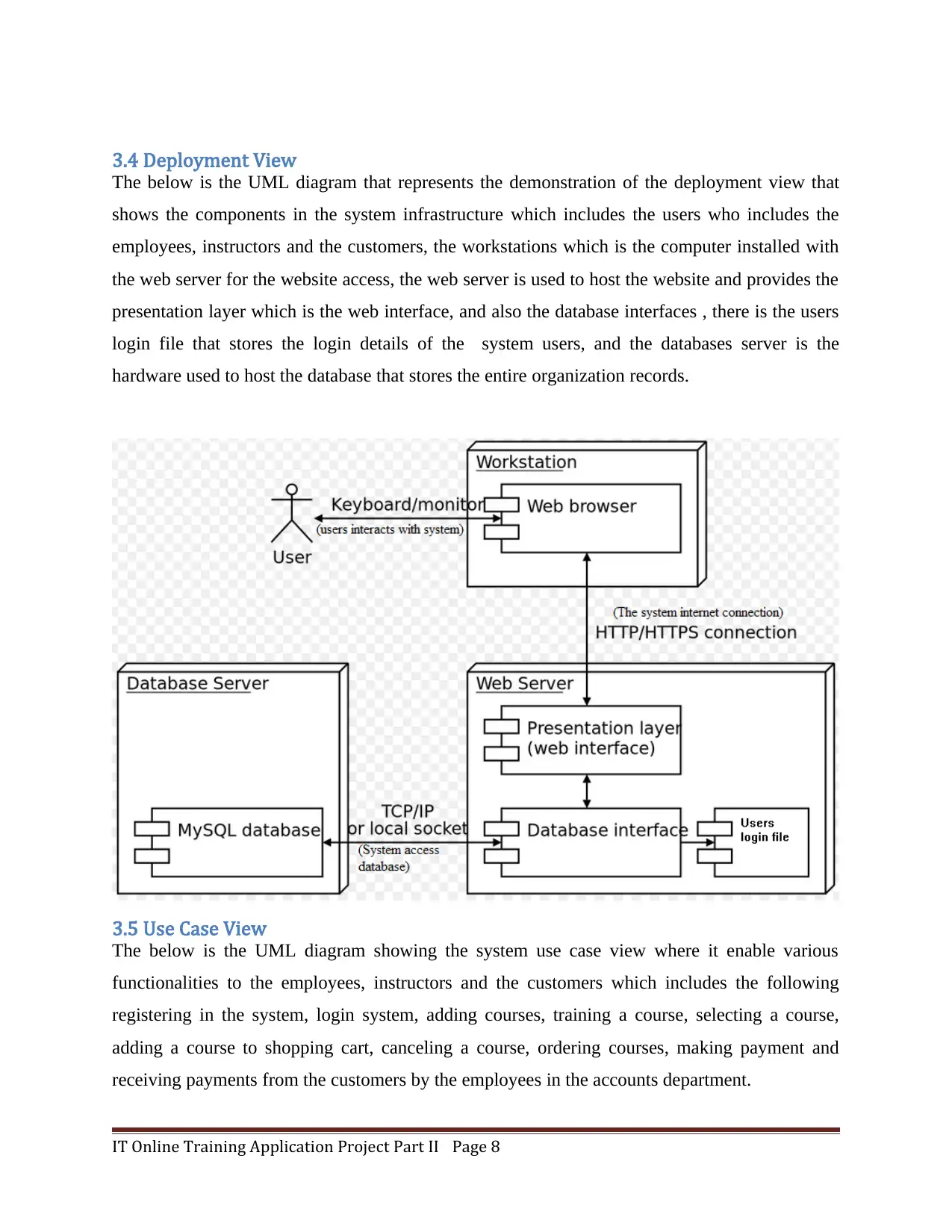
3.4 Deployment View
The below is the UML diagram that represents the demonstration of the deployment view that
shows the components in the system infrastructure which includes the users who includes the
employees, instructors and the customers, the workstations which is the computer installed with
the web server for the website access, the web server is used to host the website and provides the
presentation layer which is the web interface, and also the database interfaces , there is the users
login file that stores the login details of the system users, and the databases server is the
hardware used to host the database that stores the entire organization records.
3.5 Use Case View
The below is the UML diagram showing the system use case view where it enable various
functionalities to the employees, instructors and the customers which includes the following
registering in the system, login system, adding courses, training a course, selecting a course,
adding a course to shopping cart, canceling a course, ordering courses, making payment and
receiving payments from the customers by the employees in the accounts department.
IT Online Training Application Project Part II Page 8
The below is the UML diagram that represents the demonstration of the deployment view that
shows the components in the system infrastructure which includes the users who includes the
employees, instructors and the customers, the workstations which is the computer installed with
the web server for the website access, the web server is used to host the website and provides the
presentation layer which is the web interface, and also the database interfaces , there is the users
login file that stores the login details of the system users, and the databases server is the
hardware used to host the database that stores the entire organization records.
3.5 Use Case View
The below is the UML diagram showing the system use case view where it enable various
functionalities to the employees, instructors and the customers which includes the following
registering in the system, login system, adding courses, training a course, selecting a course,
adding a course to shopping cart, canceling a course, ordering courses, making payment and
receiving payments from the customers by the employees in the accounts department.
IT Online Training Application Project Part II Page 8
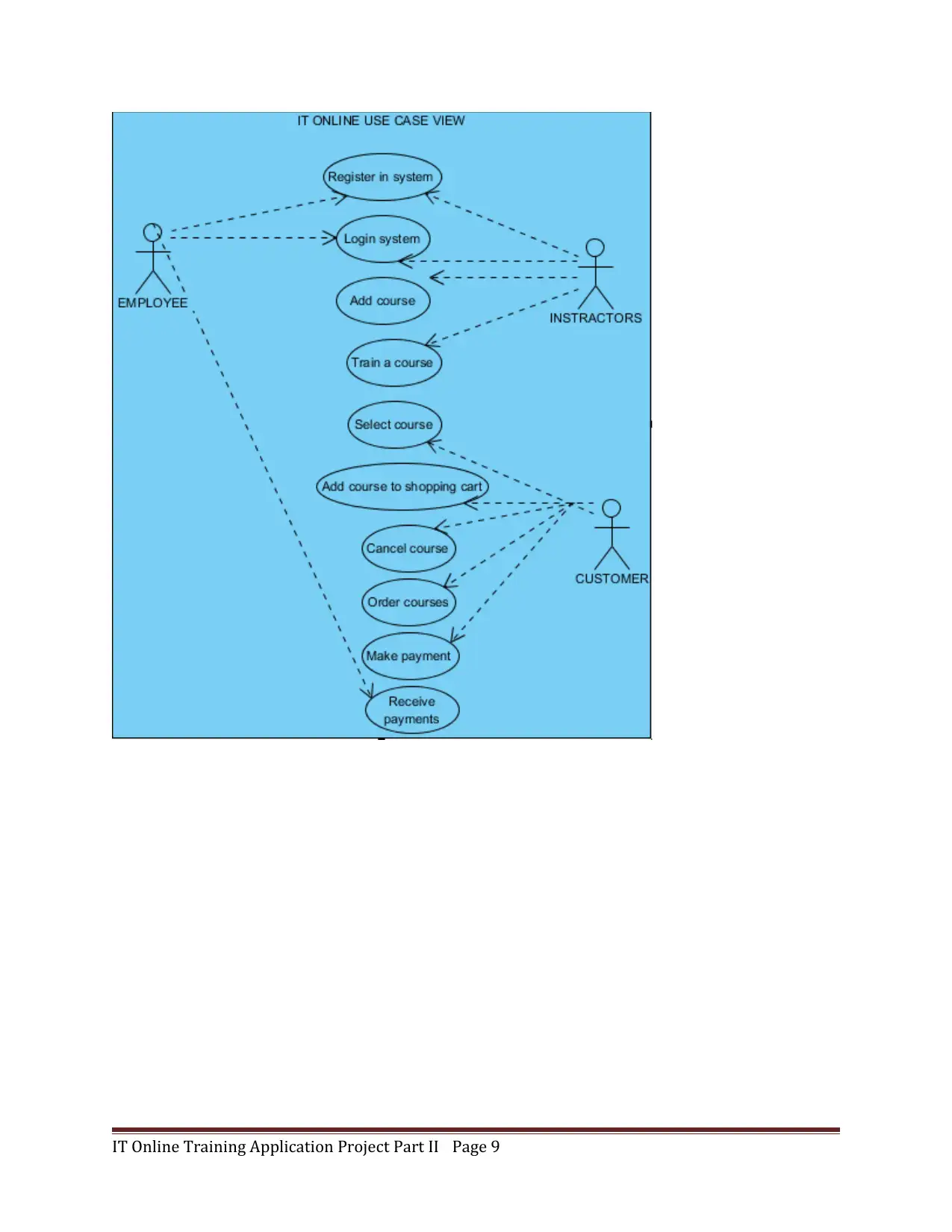
IT Online Training Application Project Part II Page 9
⊘ This is a preview!⊘
Do you want full access?
Subscribe today to unlock all pages.

Trusted by 1+ million students worldwide
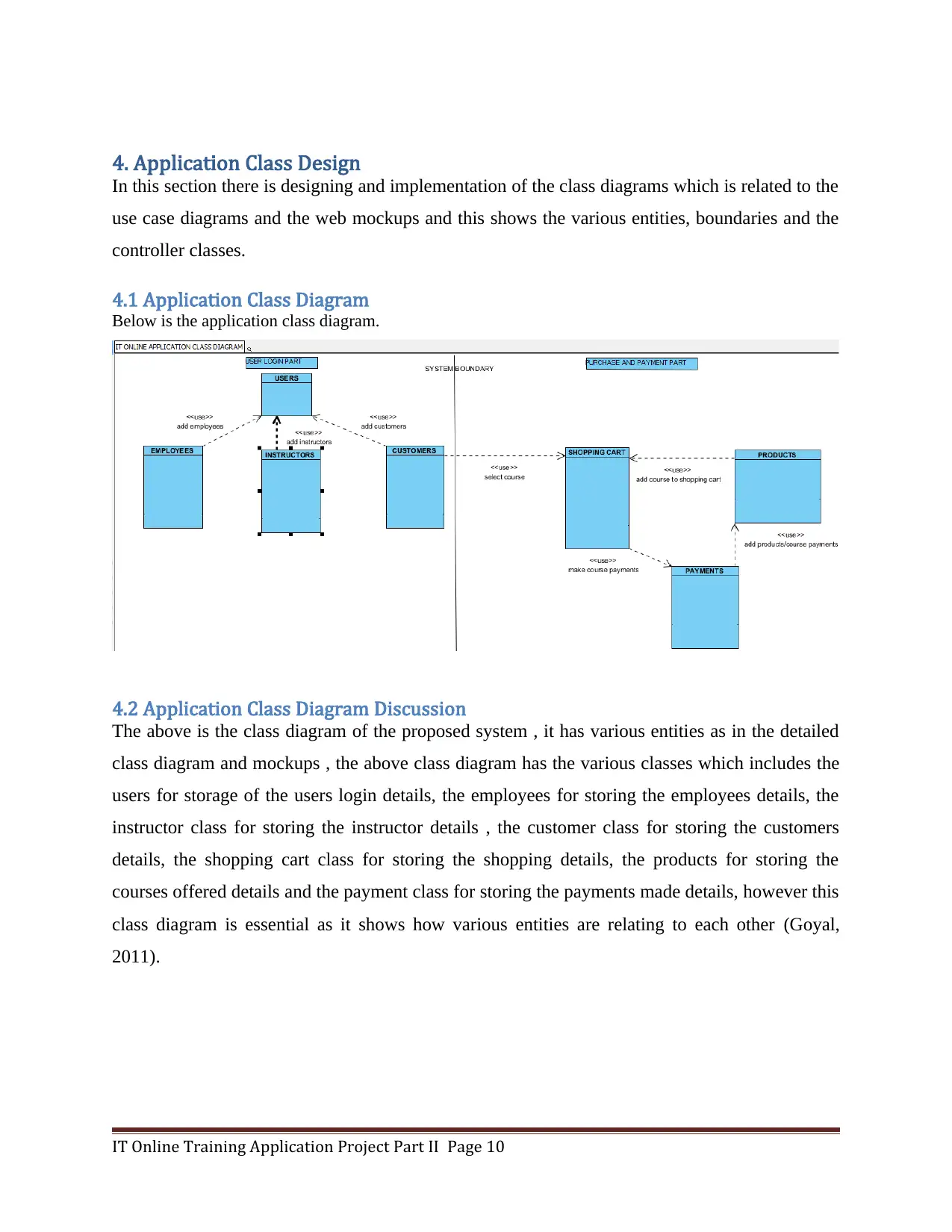
4. Application Class Design
In this section there is designing and implementation of the class diagrams which is related to the
use case diagrams and the web mockups and this shows the various entities, boundaries and the
controller classes.
4.1 Application Class Diagram
Below is the application class diagram.
4.2 Application Class Diagram Discussion
The above is the class diagram of the proposed system , it has various entities as in the detailed
class diagram and mockups , the above class diagram has the various classes which includes the
users for storage of the users login details, the employees for storing the employees details, the
instructor class for storing the instructor details , the customer class for storing the customers
details, the shopping cart class for storing the shopping details, the products for storing the
courses offered details and the payment class for storing the payments made details, however this
class diagram is essential as it shows how various entities are relating to each other (Goyal,
2011).
IT Online Training Application Project Part II Page 10
In this section there is designing and implementation of the class diagrams which is related to the
use case diagrams and the web mockups and this shows the various entities, boundaries and the
controller classes.
4.1 Application Class Diagram
Below is the application class diagram.
4.2 Application Class Diagram Discussion
The above is the class diagram of the proposed system , it has various entities as in the detailed
class diagram and mockups , the above class diagram has the various classes which includes the
users for storage of the users login details, the employees for storing the employees details, the
instructor class for storing the instructor details , the customer class for storing the customers
details, the shopping cart class for storing the shopping details, the products for storing the
courses offered details and the payment class for storing the payments made details, however this
class diagram is essential as it shows how various entities are relating to each other (Goyal,
2011).
IT Online Training Application Project Part II Page 10
Paraphrase This Document
Need a fresh take? Get an instant paraphrase of this document with our AI Paraphraser
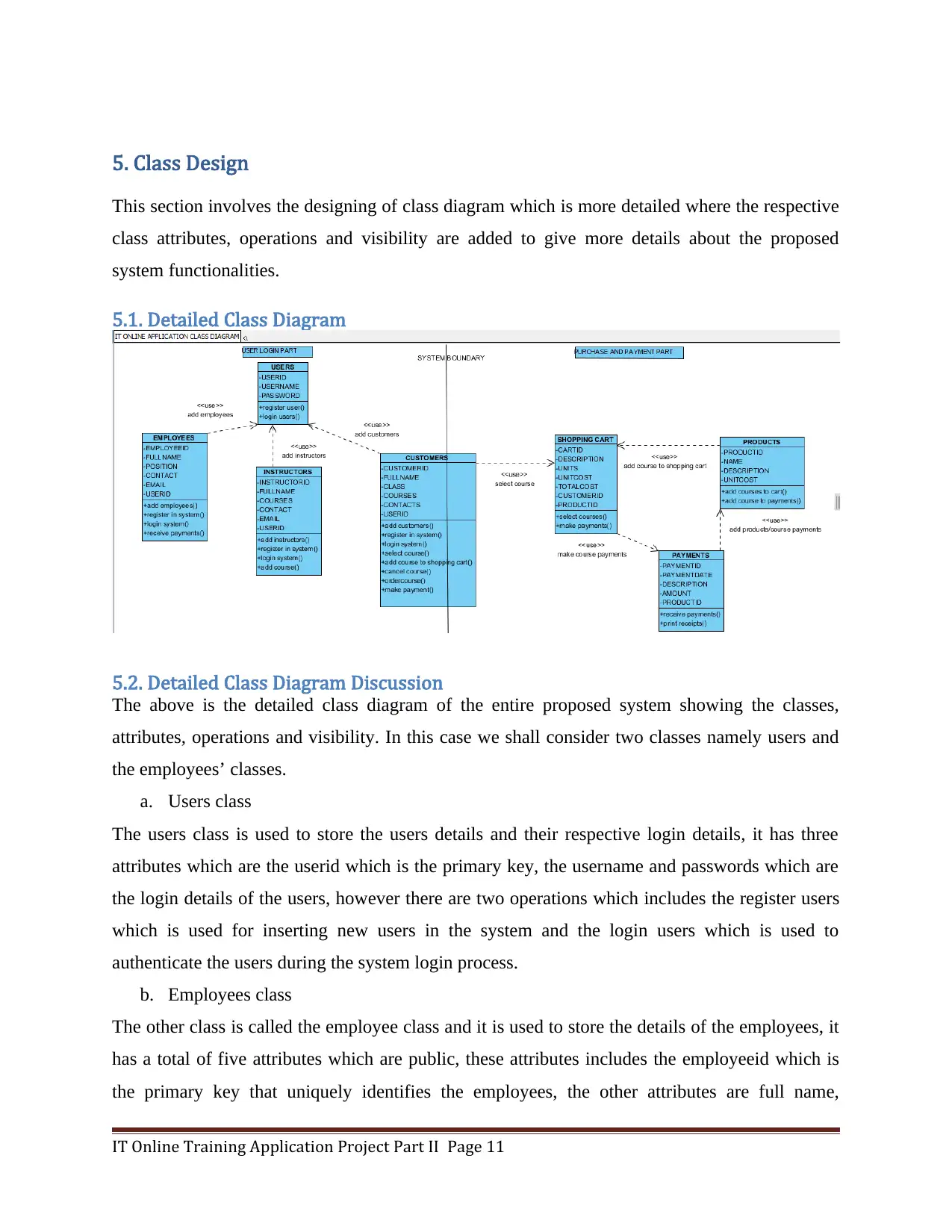
5. Class Design
This section involves the designing of class diagram which is more detailed where the respective
class attributes, operations and visibility are added to give more details about the proposed
system functionalities.
5.1. Detailed Class Diagram
5.2. Detailed Class Diagram Discussion
The above is the detailed class diagram of the entire proposed system showing the classes,
attributes, operations and visibility. In this case we shall consider two classes namely users and
the employees’ classes.
a. Users class
The users class is used to store the users details and their respective login details, it has three
attributes which are the userid which is the primary key, the username and passwords which are
the login details of the users, however there are two operations which includes the register users
which is used for inserting new users in the system and the login users which is used to
authenticate the users during the system login process.
b. Employees class
The other class is called the employee class and it is used to store the details of the employees, it
has a total of five attributes which are public, these attributes includes the employeeid which is
the primary key that uniquely identifies the employees, the other attributes are full name,
IT Online Training Application Project Part II Page 11
This section involves the designing of class diagram which is more detailed where the respective
class attributes, operations and visibility are added to give more details about the proposed
system functionalities.
5.1. Detailed Class Diagram
5.2. Detailed Class Diagram Discussion
The above is the detailed class diagram of the entire proposed system showing the classes,
attributes, operations and visibility. In this case we shall consider two classes namely users and
the employees’ classes.
a. Users class
The users class is used to store the users details and their respective login details, it has three
attributes which are the userid which is the primary key, the username and passwords which are
the login details of the users, however there are two operations which includes the register users
which is used for inserting new users in the system and the login users which is used to
authenticate the users during the system login process.
b. Employees class
The other class is called the employee class and it is used to store the details of the employees, it
has a total of five attributes which are public, these attributes includes the employeeid which is
the primary key that uniquely identifies the employees, the other attributes are full name,
IT Online Training Application Project Part II Page 11
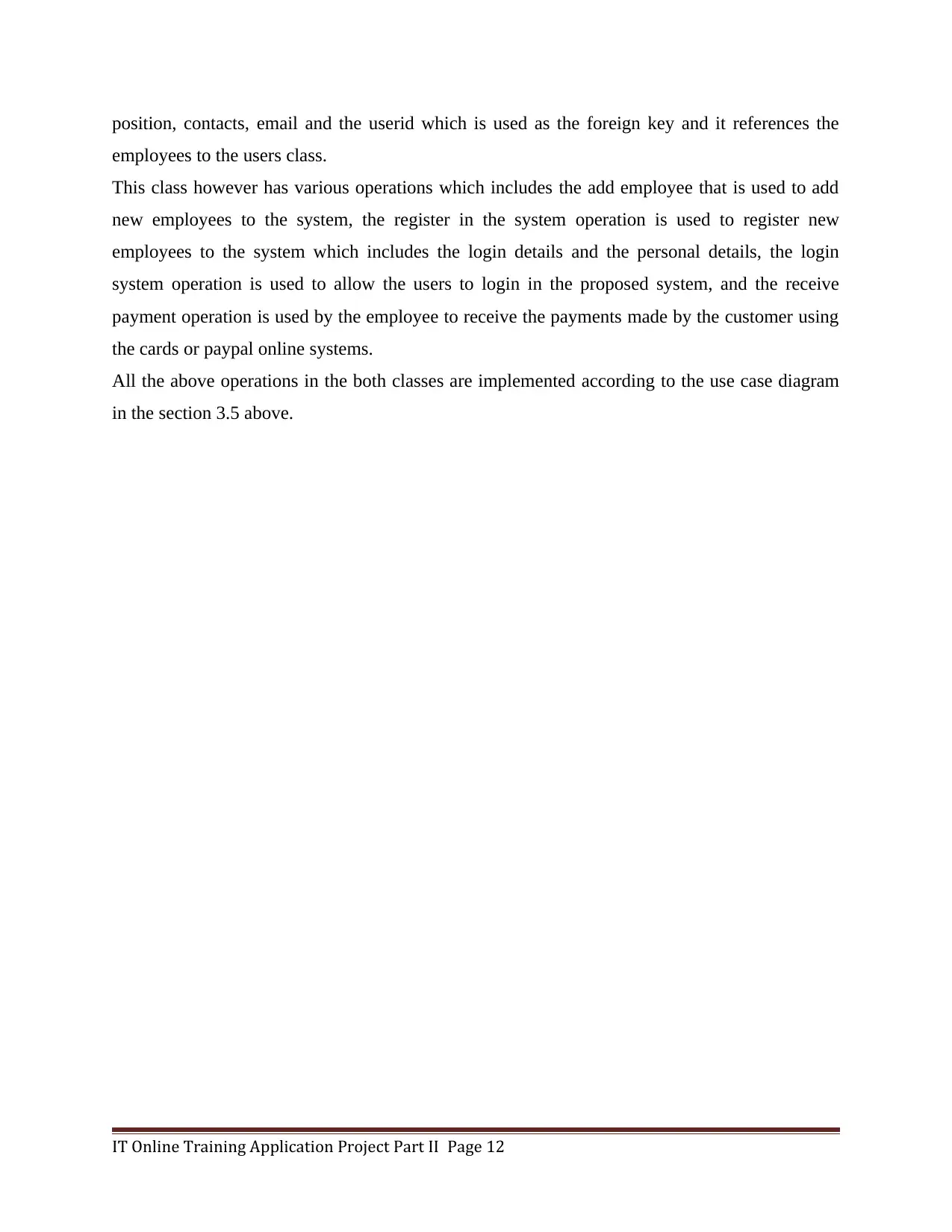
position, contacts, email and the userid which is used as the foreign key and it references the
employees to the users class.
This class however has various operations which includes the add employee that is used to add
new employees to the system, the register in the system operation is used to register new
employees to the system which includes the login details and the personal details, the login
system operation is used to allow the users to login in the proposed system, and the receive
payment operation is used by the employee to receive the payments made by the customer using
the cards or paypal online systems.
All the above operations in the both classes are implemented according to the use case diagram
in the section 3.5 above.
IT Online Training Application Project Part II Page 12
employees to the users class.
This class however has various operations which includes the add employee that is used to add
new employees to the system, the register in the system operation is used to register new
employees to the system which includes the login details and the personal details, the login
system operation is used to allow the users to login in the proposed system, and the receive
payment operation is used by the employee to receive the payments made by the customer using
the cards or paypal online systems.
All the above operations in the both classes are implemented according to the use case diagram
in the section 3.5 above.
IT Online Training Application Project Part II Page 12
⊘ This is a preview!⊘
Do you want full access?
Subscribe today to unlock all pages.

Trusted by 1+ million students worldwide
1 out of 19
Related Documents
Your All-in-One AI-Powered Toolkit for Academic Success.
+13062052269
info@desklib.com
Available 24*7 on WhatsApp / Email
![[object Object]](/_next/static/media/star-bottom.7253800d.svg)
Unlock your academic potential
Copyright © 2020–2025 A2Z Services. All Rights Reserved. Developed and managed by ZUCOL.





